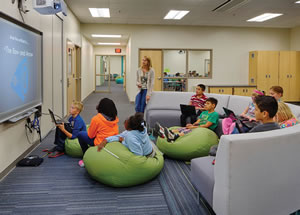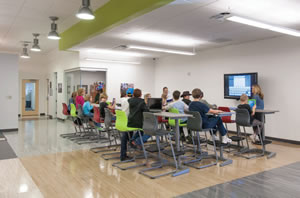Flipping Technology
- By Michael Fickes
- 11/01/14

PHOTO COURTESY OF I.J. HOLTON INTERMEDIATE SCHOOL/ATS&R PLANNERS/ARCHITECTS/ENGINEERS
Thinking about flipping your school’s classrooms? If so, you are not alone. According to a survey conducted by Sophia, an online college and educational resource, and the Flipped Learning Network, 96 percent of teachers recognize the term flipped classroom.
Seventy-eight percent of teachers have tried flipping at least one lesson, continues the survey. Forty-five percent of teachers — almost half — flip their classes once or twice a week; 20 percent flip three to four times per week; and 5.4 have flipped their classrooms permanently.
Of the teachers who do not flip their classrooms, 89 percent are interested in learning more about it.
Flipped classrooms began to catch on back in the mid-2000s, as more and more teachers came to realize that today’s more complex and detailed curricula required a different teaching model. These teachers realized that students most needed personal attention from teachers while they struggled with complicated homework assignments. So, they reasoned, why not do homework in class and make video lectures and presentations that students could view at home?
At home, viewing the lecture on a smartphone or tablet, students would have the power to pause, rewind and go over tough concepts again.
The following day, in class, students would work alone or in groups to apply the concepts learned the night before to problems. The teacher would roam the classroom helping students having trouble with the lesson.
Technology makes flipping possible
Modern technology has made it possible to flip classrooms inexpensively. Before flipping a classroom, however, teachers must make sure their students can access the video materials. Most probably can, but it’s important to check and to figure out solutions for students that lack the tools.
Teachers from poor urban school districts note that many of their students have smartphones and can access the videos that way. Students can also plan form groups and access the materials together at the home of friends with computers and Internet access.
In their 2014 book, “Flipped Learning: Gateway to Student Engagement,” co-authors Jonathan Bergmann and Aaron Sams address the problem of student access by listing some technological work-arounds.
Students may have a computer at home but no access to the Internet. In such cases, a teacher can download videos to a thumb drive that the student can take home.
If there is no computer at home, Bergmann and Sams burn the videos onto a DVD, and students watch them on television.
For those that have no DVD player, Bergmann and Sams suggest that the school or the district buy a number of inexpensive DVD players and check them out to students.
The point is that teachers and administrators can solve student access problems with creative ideas.
Once the access problems have been solved, a teacher can go online and find lectures that support lesson plans. Teachers that flip their classes and make their own videos often post their materials online so that others can use them. The Internet houses numerous websites with lectures in virtually any discipline. YouTube, for instance, has 60,000 lectures posted by teachers from across the country.
A teacher just getting started with flipping can grab appropriate videos and post them on the school website for the students to access and view.
Then teachers must prepare exercises, problems to solve or other activities for the next day’s class to ensure that the concepts presented by the video have been clearly understood. And, voila, the classroom is flipped.

PHOTO COURTESY OF FALCON VIRTUAL ACADEMY/DLR GROUP
Technology for making videos
While some teachers prefer to use other teacher’s videos, most want to put their own stamp on their courses with their own videos.
An earlier book (2012) by Bergmann and Sams, “Flip This Classroom: Reach Every Student in Every Classroom Every Day”, focuses on the technology required for making video lectures and presentations:
“Our videos are very inexpensive to make. All we have is screencasting software, a computer, a pen-tablet input devices, a microphone and a webcam. Most newer computers today have a microphone and webcam built in, so the only two things you will need to purchase are the pen-tablet input device and the software.”
Screencasting software records the presentations. It captures the PowerPoint slides, websites, web-sourced video and annotations that appear on a computer screen as a teacher creates video lectures. It will also record the teacher’s voice when a microphone is added to the mix.
Andrew Douch, an Edtech consultant, posted a blog entry reviewing 16 screencasting software applications. Douch recommends Screencast-O-Matic, www.screencastomatic.com, for teachers just beginning to make videos. It offers free Mac and Windows versions and records a webcam and screen — but not audio. It limits recordings to 15 minutes, and virtually everyone recommends short videos from 10 to 15 minutes, so that isn’t much of a problem.
The Pro version of Screencast-O-Matic, which costs $15 per year, does record audio and removes the 15-minute limit. One note: veteran flippers recommend short videos — five to 15 minutes — tightly focused on one idea.
To check out Douch’s screencasting software reviews, go to www.andrewdouch. wordpress.com and scroll down through the current posts to the list of recent posts. Select “The best screencasting software for teachers.
Annotation technology enables teachers to write on presentation frames and call out important concepts. PowerPoint software offers annotation feature. Other presentation software applications my require a USB pen and tablet that plugs into your computer.
Bergmann and Sams also note that wireless tablets, which are more expensive, make life easier for teachers that record lessons live and want to move around the classroom while presenting.
Interactive whiteboards, used by many teachers to record lessons, include a pen for annotating.
Microphones are built into today’s laptops, but Bergmann and Sams caution that the quality is low. They suggest testing the audio quality and if it isn’t good enough, buying an external microphone that can produce audio suited to the course. Language teachers, for instance, require precise audio that enables students to pick up subtle pronunciations. Once again, moving around the classroom while recording live requires a wireless external microphone.
Webcams typically come with new laptops. Teachers should investigate picture-in-picture feature offered by their webcam. This feature enables teachers to insert a small headshot of themselves into the presentation. Bergmann and Sams say that students like seeing the speaker and the presentation.
Webcams do have limits however. A teacher might want to record a scene from the real world to include in a presentation. That would require a video camera.
Flipped classrooms can use all of these technologies. But it is important to remember that technologies are tools. Just like hammers and saws, technology tools don’t do anything without an artisan. Hammers and saws make it possible for artisans to build buildings, and classroom technologies make it possible for teacher-artisans to flip classrooms and engage their students in a more all-encompassing approach to learning.
This article originally appeared in the issue of .